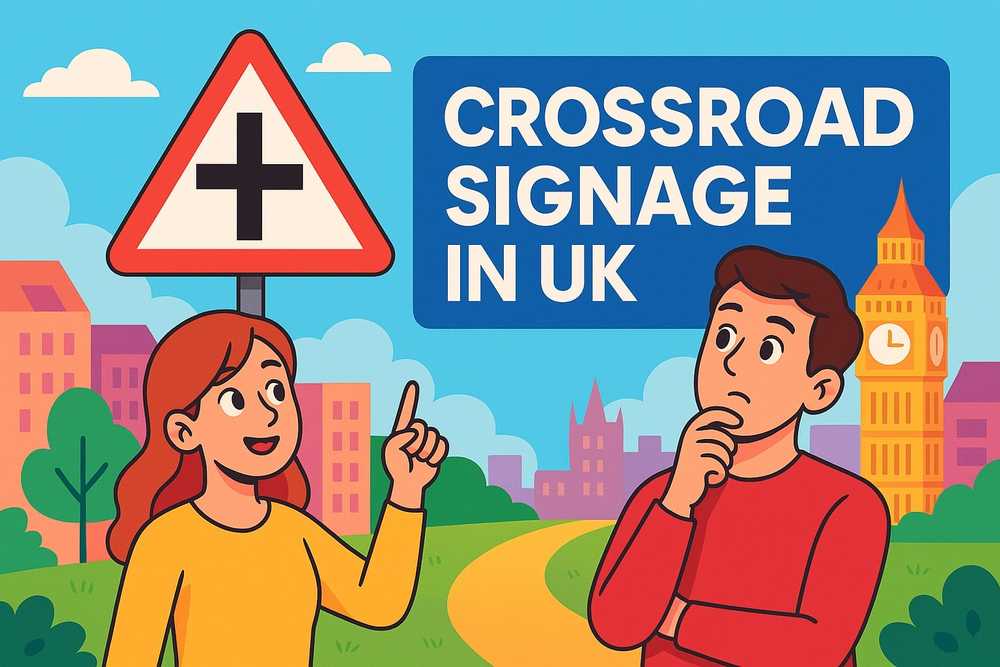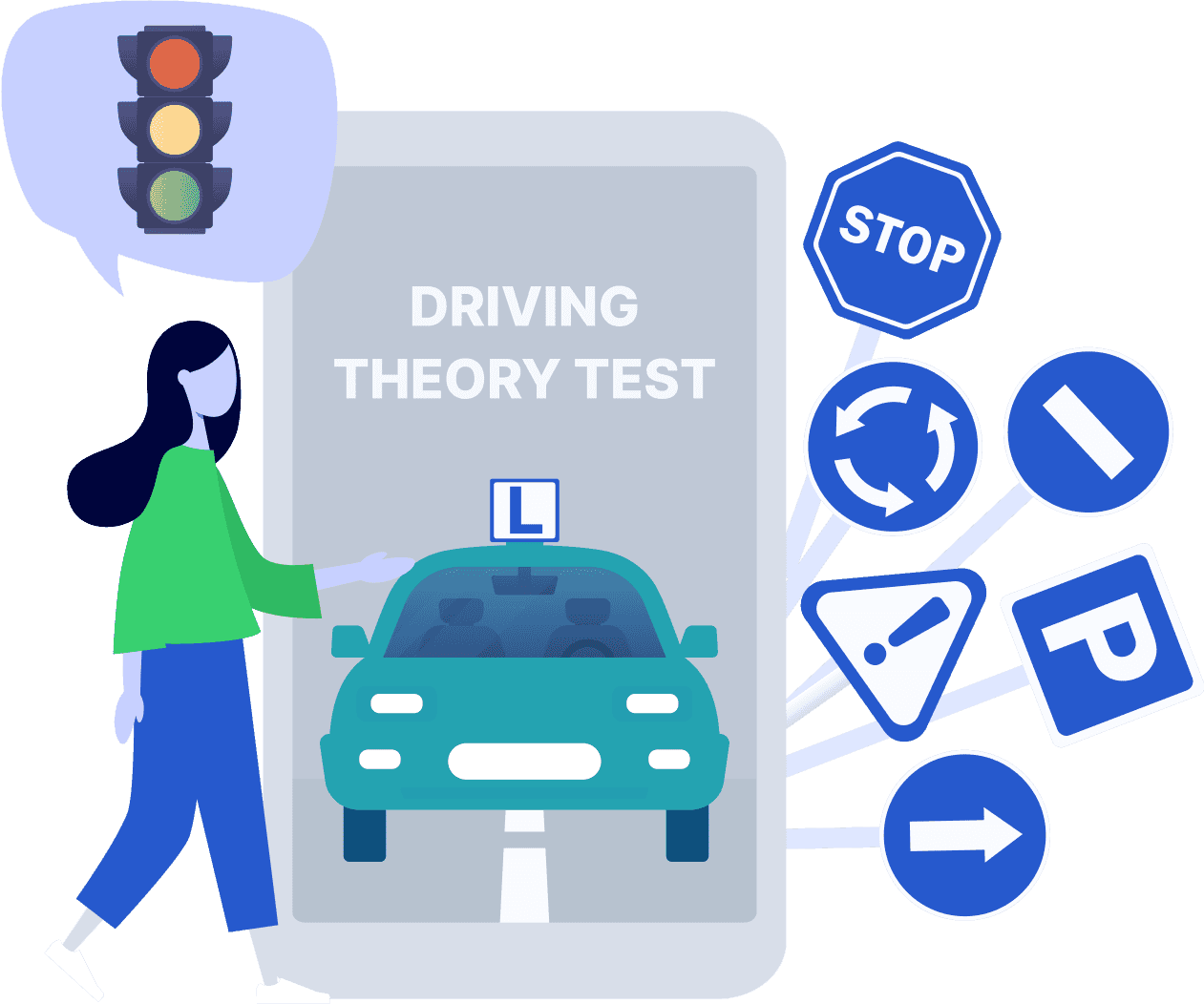Crossroad Sign in UK
Crossroad signage plays a vital role in road safety by warning drivers of upcoming intersections where two roads meet. These signs , often accompanied by traffic lights or stop signs, help regulate traffic flow and reduce accidents. Understanding the different types of crossroad signs, their meanings, and how to navigate them is essential for safe driving. This guide explains the basics of crossroad signage, common mistakes to avoid, and tips for handling complex intersections, ensuring you stay confident and secure on the road.
Before we delve into the definition of crossroad signs, it’s better to first understand what a crossroad means. After that, we will discuss in more depth the traffic signs that are installed at crossroads.
What Does Crossroad Mean?
A crossroad refers to a point where two or more roads intersect, or where one road crosses another. These points are highly significant in driving, and one must pass through them with caution because the likelihood of accidents at these points is very high. For this reason, warning signs are installed for drivers before reaching these points. Now that we have a better understanding of these points, let’s learn more about the traffic signs that are installed before these intersections.
What Is Cross Road Sign - Purpose and Meanings
Crossroad signage is part of road signs that are installed before intersections or in areas where visibility is limited. These signs:
- Inform drivers of an upcoming intersection or a point where another road crosses their path,
- Prompting them to reduce their speed,
- Watch for traffic, and be prepared to stop or yield if necessary.
Cross road signs are crucial for road safety as they alert drivers to potential hazards and the possibility of traffic coming from other directions.
Where Is Crossroad Signage Commonly Used?
The Crossroad sign is typically found on a minor road that will cross with a major road. A stoplight, or a Give Way or Stop Sign oftentimes accompanies it for traffic safety and control. This sign is mounted on posts or supports and strategically placed on the minor road where it is easily visible. In the following, we will explain this topic in greater depth:
Crossroad signage, specifically the “Crossroads ahead” sign, is commonly used in the following contexts, as detailed in the Traffic Signs Regulations and General Directions 2016 :
1- Approaches to Crossroads:
-
The sign is placed on roads approaching a junction where cross traffic exists, particularly where the crossroads may not be immediately visible to drivers due to bends, gradients, or other obstructions.
-
It warns drivers to prepare for intersecting traffic from both directions.
2- Combination with Supplementary Plates
- The sign is often paired with a first associated plate (e.g., “A distance”) to indicate the proximity of the crossroads. For example:
“200 yds” (imperial units) may be added to specify the distance to the hazard.
- Supplementary plates may also include directional arrows (left/right) if the crossroads layout is asymmetrical.
3- Hazardous Locations:
Crossroads signs are mandated in areas where the layout or visibility of the junction poses a risk, such as:
- Rural roads with poor sightlines.
- Urban areas with complex traffic flows.
-
Roads leading to intersections with unprioritized traffic (no “Give Way” or “Stop” signs). Roads leading to intersections with unprioritized traffic (no “Give Way” or “Stop” signs).
4- Temporary Situations
During roadworks or temporary changes to road layouts (e.g., diversions), crossroad signage may be deployed to guide drivers safely through altered traffic patterns.
Different Type of Crossroad in UK
- Unmarked Junctions:
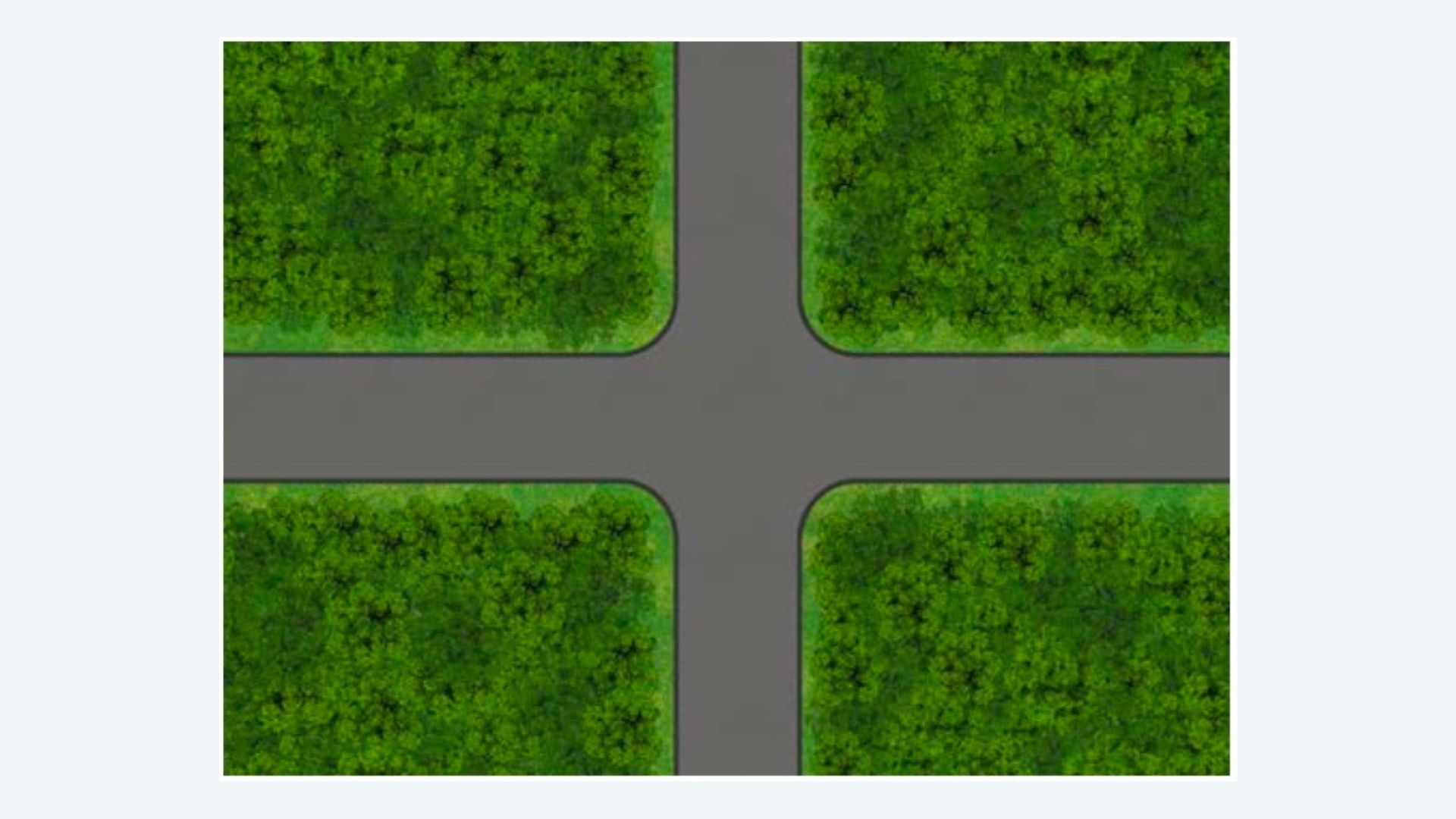
These junctions, commonly found in non-urban and rural areas, do not have any signs or road markings to indicate priority. Official guidance emphasises that at such junctions, no one has priority, and all drivers must approach and cross them with caution.
- Priority-Controlled Junctions with Signs:
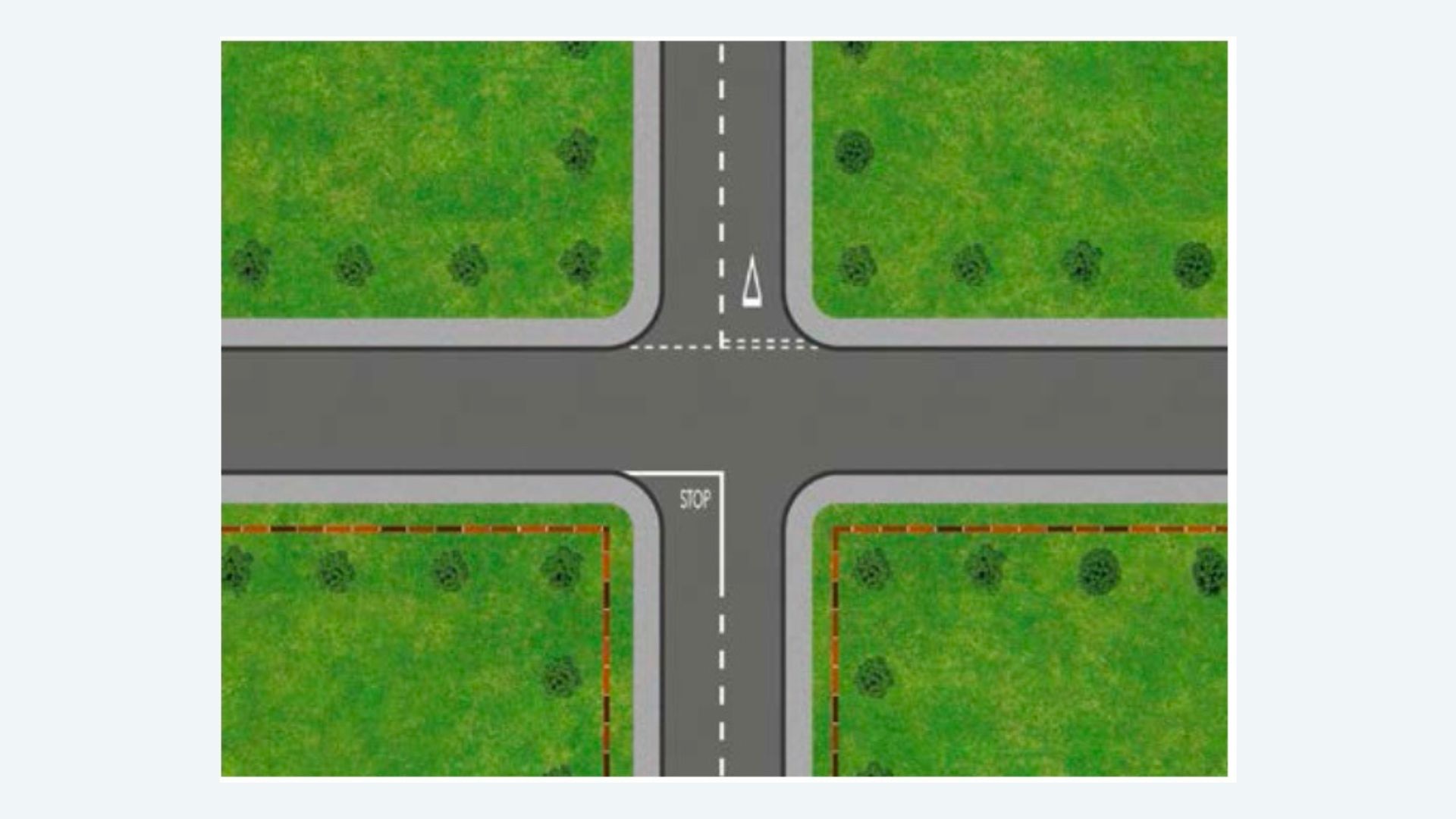
These junctions include signs or road markings such as ‘STOP’ signs and stop lines on minor roads, or ‘GIVE WAY’ signs and broken white lines on major roads. These indicate which route has priority. In these cases, drivers on the major road have priority, and drivers on the minor road must obey the signs, stop at the stop line, and give way to priority traffic — only proceeding when it is safe to do so.
- Signal-Controlled Junctions:
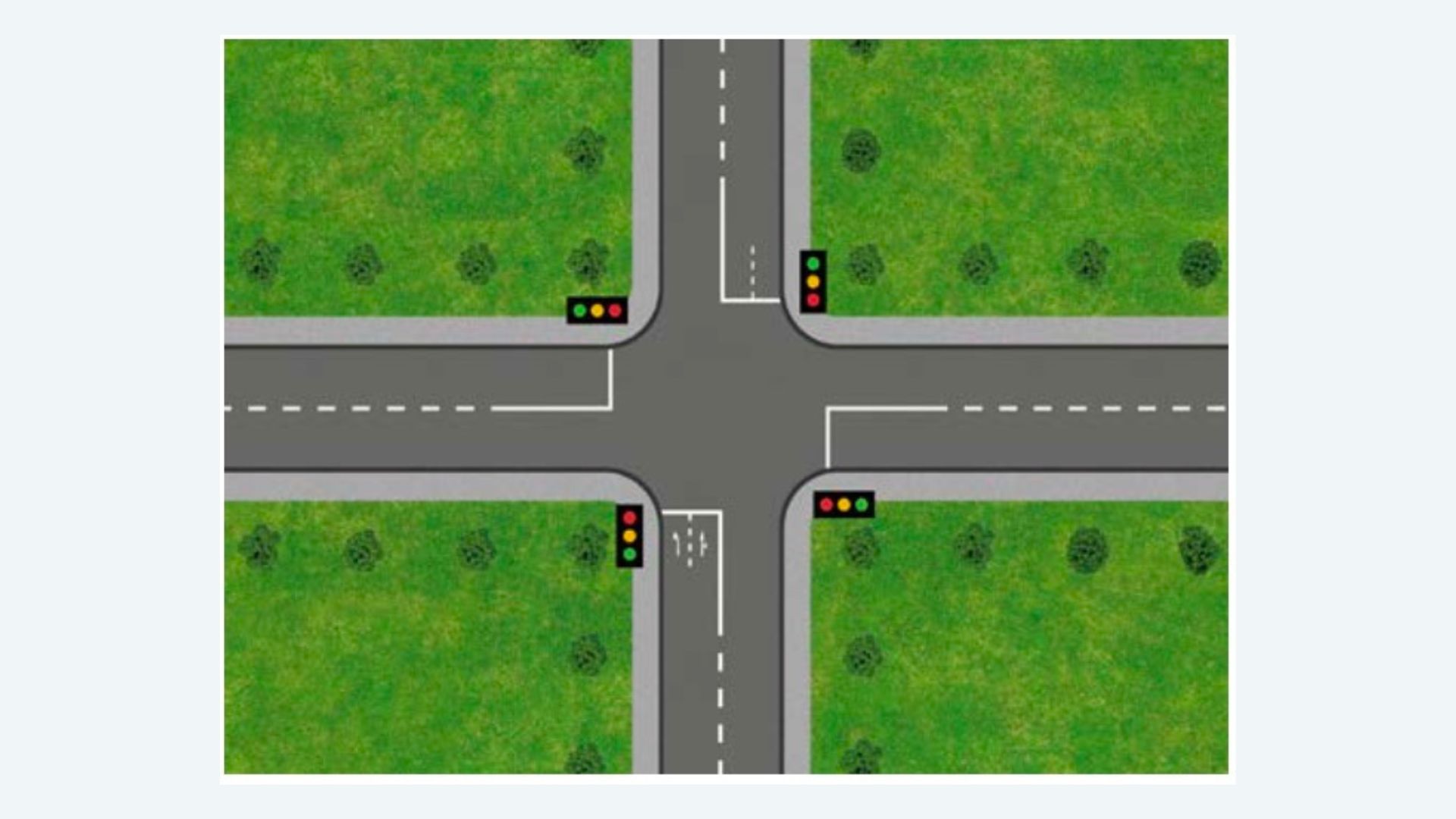
In busy urban areas, traffic lights are often used to control the flow of vehicles at junctions. In these junctions, the traffic lights determine priority, and drivers must stop at red and amber lights, only proceeding when the light is green and the exit is clear. The Highway Code stresses that drivers must not enter the junction unless their exit is clear, even if the light is green, as this helps prevent the junction from becoming blocked.
Another important point is that if the traffic lights are out of order for any reason, the official rule is to treat the junction as an unmarked junction and proceed with extreme caution — because no one has priority under those conditions.
- Box Junctions:
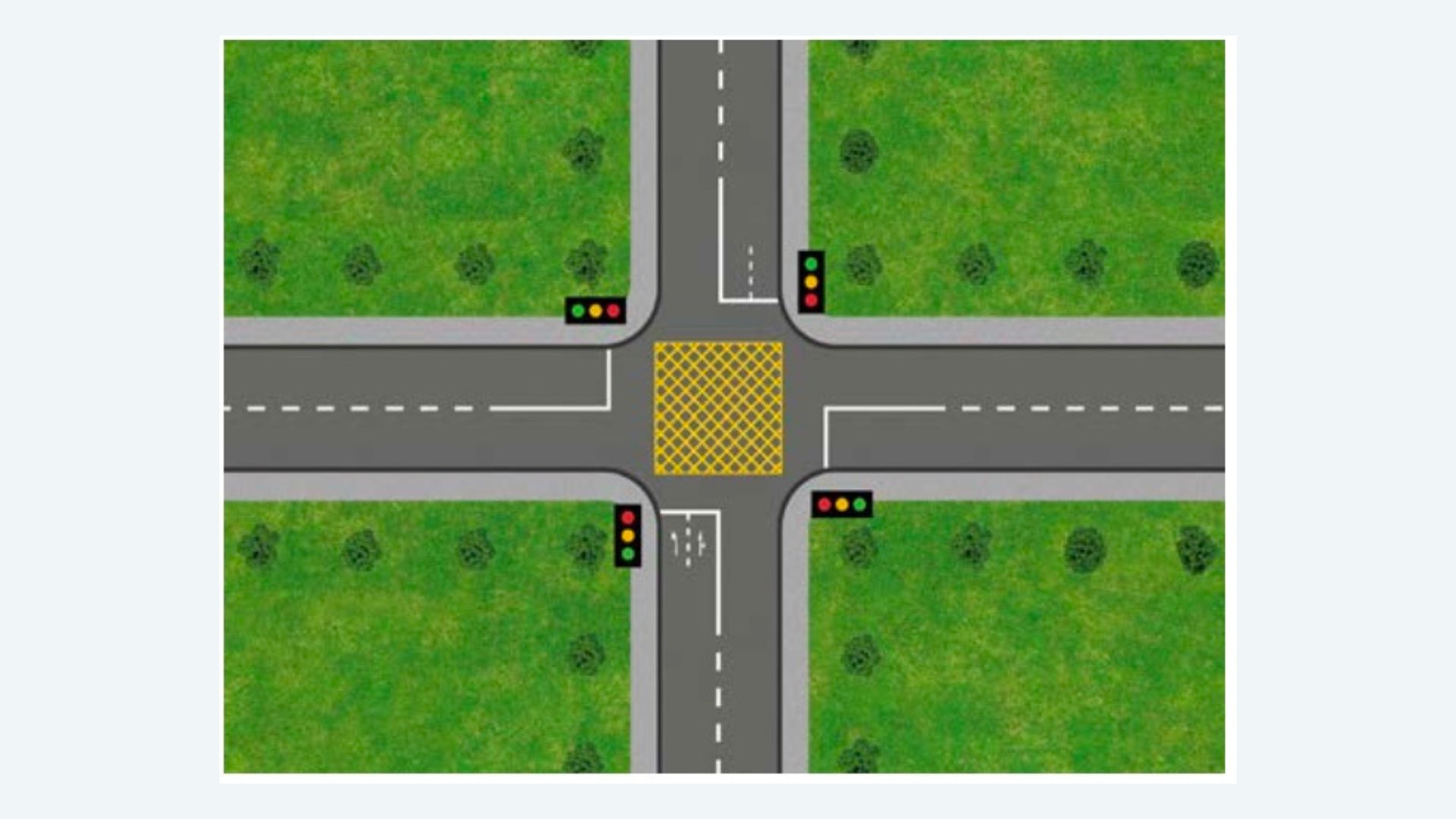
A box junction is a road marking typically used at junctions (especially busy ones) to help prevent gridlock. It is marked with criss-cross yellow lines painted on the road surface. According to the Highway Code , you must not enter a box junction unless your exit is completely clear — meaning, when approaching a junction with yellow box markings, you may only enter it if there is enough space on the other side for your vehicle to exit completely. (There is one exception: if you are turning right and are prevented from doing so only by oncoming traffic or other vehicles also waiting to turn right.)
- Staggered Junctions:
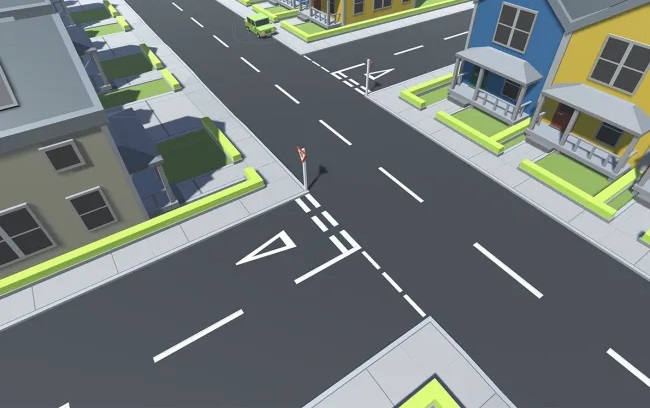
Staggered junctions refer to a layout where the side roads do not align directly opposite each other, but are offset. Officially, these are described as “staggered junctions, where roads join from the left and right but the route between side roads is not direct.”
In other words, if you wish to cross from one side road to the one opposite, you cannot do so directly — you must first enter the main road, and then exit it again. UK road signs include specific warning symbols for this type of junction (typically showing two side roads entering the main road at offset angles to the left and right) to alert drivers to this layout.
This indicates that staggered junctions are officially recognised. Drivers approaching such junctions should be aware that crossing is done in two stages and must take extra care regarding unusual priority rules or potential hazards, as the side roads are not directly aligned. The description — “offset side roads crossing the main road in two stages” — accurately reflects the nature of a staggered junction according to British driving sources.
Different Types of Crossroad Signs
In the UK, there are both basic and advanced crossroads and if you want to get your driving license its crucial to understand them correctly. Nonetheless, a very similar sign is used for all types of crossroads. Because the Crossroad Sign is a warning sign , like other signs in this category, It is a white triangle that is trimmed in red to show that it is highly important to road safety.
Basic Crossroad Signs
A basic crossroad is an intersection where just two roads meet. It is usually in smaller cities where there is less traffic. This type of road is easier to maneuver because there are fewer cars to contend with. Unlike advanced crossroad signs where traffic is controlled by traffic lights, Stop signs are used to control traffic at these crossroads.
Advanced Crossroad Signs
One step in understanding crossroads is being able to differentiate between basic crossroads and advanced crossroads. The difference is the advanced crossroad is most often in urban areas where there is more traffic and congestion. Because there is more traffic on an advanced crossroad, navigating it can be more complicated. To minimize the risk at this junction, traffic is regulated by a traffic device such as a traffic light or a yellow box junction.
In the following text I will introduce some crossroad signs that you may see on the roads. follow me to the end:
1. Crossroads Ahead Sign:
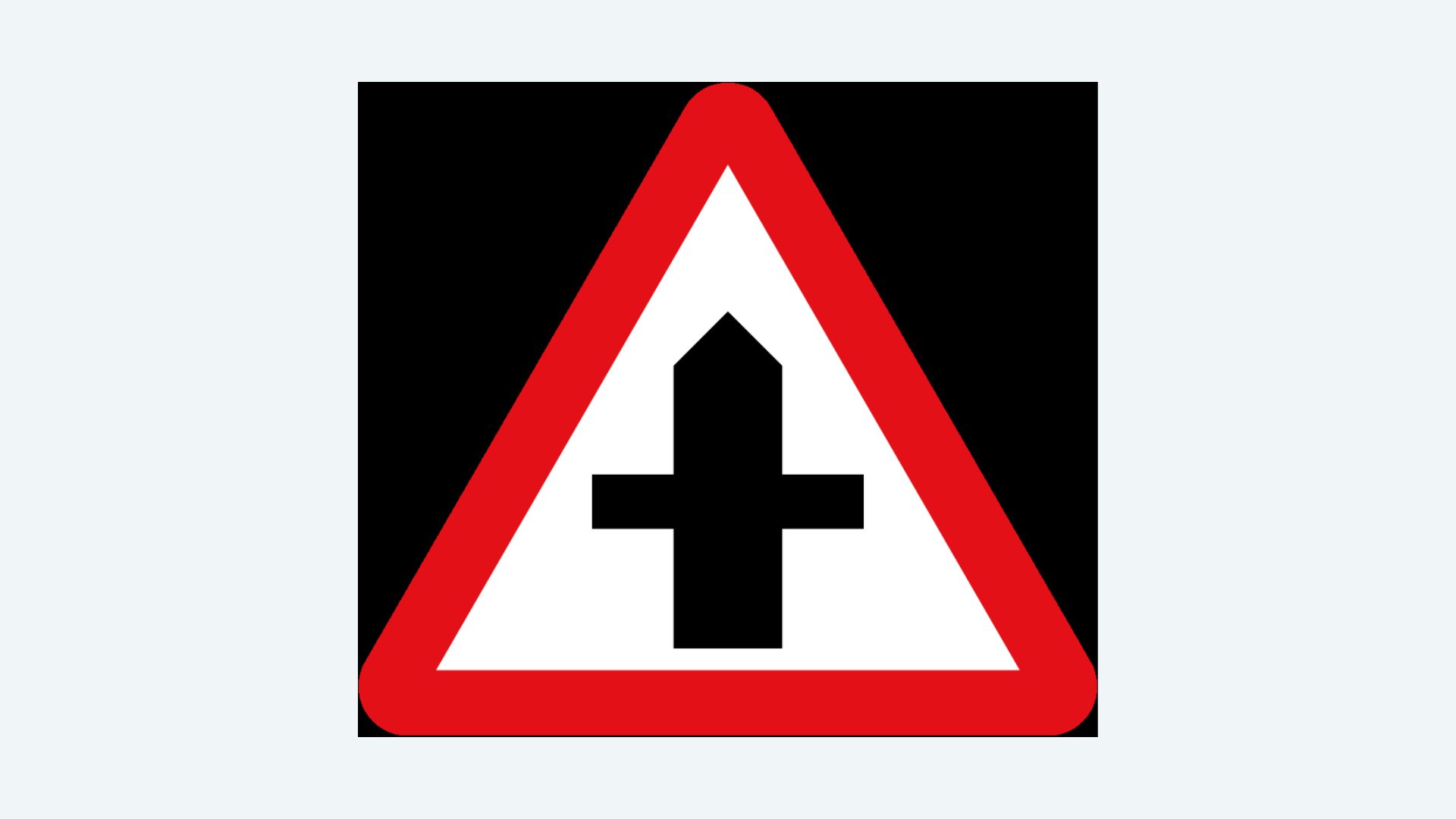
This is a triangular warning sign with a white background and a red border, featuring a black cross symbol in the center. It warns drivers that there is a crossroads ahead, where typically none of the roads have priority over the others—unless there are Give Way or Stop signs at the junction.
You’ll most often see this sign on main or rural roads where a side road intersects, especially if there are no traffic lights at the junction. It serves as an advance warning to help drivers prepare and have enough reaction time as they approach the crossroads.
2. T-Junction Ahead:

This triangular warning sign displays a T-shaped symbol and alerts drivers that a T-junction lies ahead. It’s commonly seen in rural areas or minor roads that join a major road. Additionally, this sign is often placed in locations where visibility is limited—such as curves or at night.
It’s important not to confuse this with the No Through Road sign, which also uses a T-shape but is an informational sign indicating a dead-end ahead. Sometimes, the horizontal line of the T in the sign is drawn thicker to indicate which road has priority at the junction.
3. Side Road Ahead:
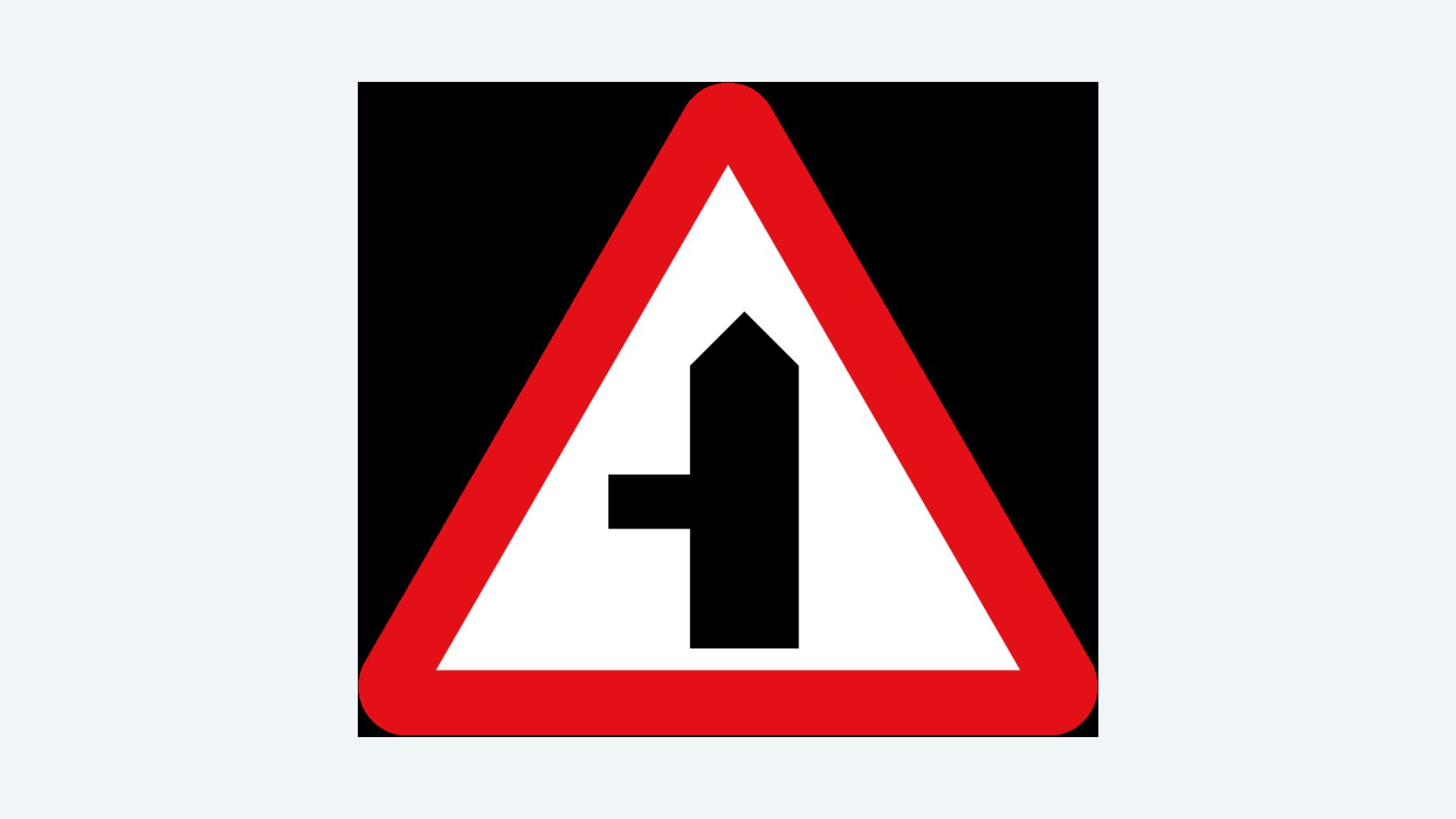
This triangular warning sign, part of the general warning sign category, is used when a side road joins a main road—especially when visibility is limited due to factors like road gradient or curves.
The shape of the sign can vary depending on whether the side road joins from the left or the right. In newer versions of the sign, the main road (which has the higher priority) is shown thicker than the side road.
4. Staggered Junction Ahead:
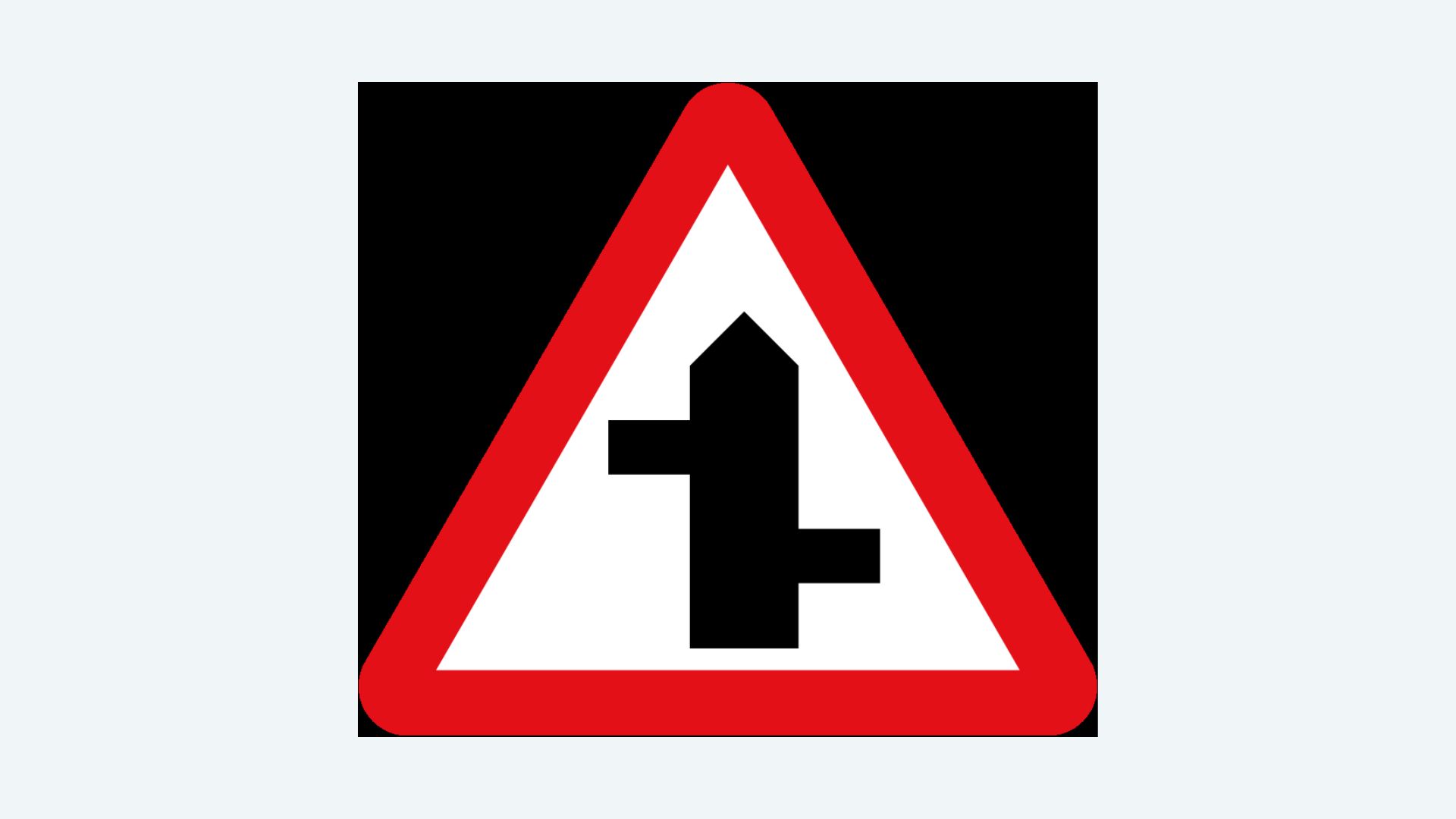
The staggered junction sign is a triangular warning sign commonly found on rural highways or A-roads. It helps prevent driver confusion by indicating two separate side roads joining the main road at slightly different points, rather than a single four-way intersection.
In these signs, the main road is typically drawn with a thicker line to indicate it has priority. The side roads are shown on the left and right, depending on which one joins the main road first.
Engineers usually implement staggered junctions for safety reasons, either when converting a four-way junction into two staggered ones or when geographical constraints prevent the creation of a traditional crossroads.
5. Junction on Bend Ahead:
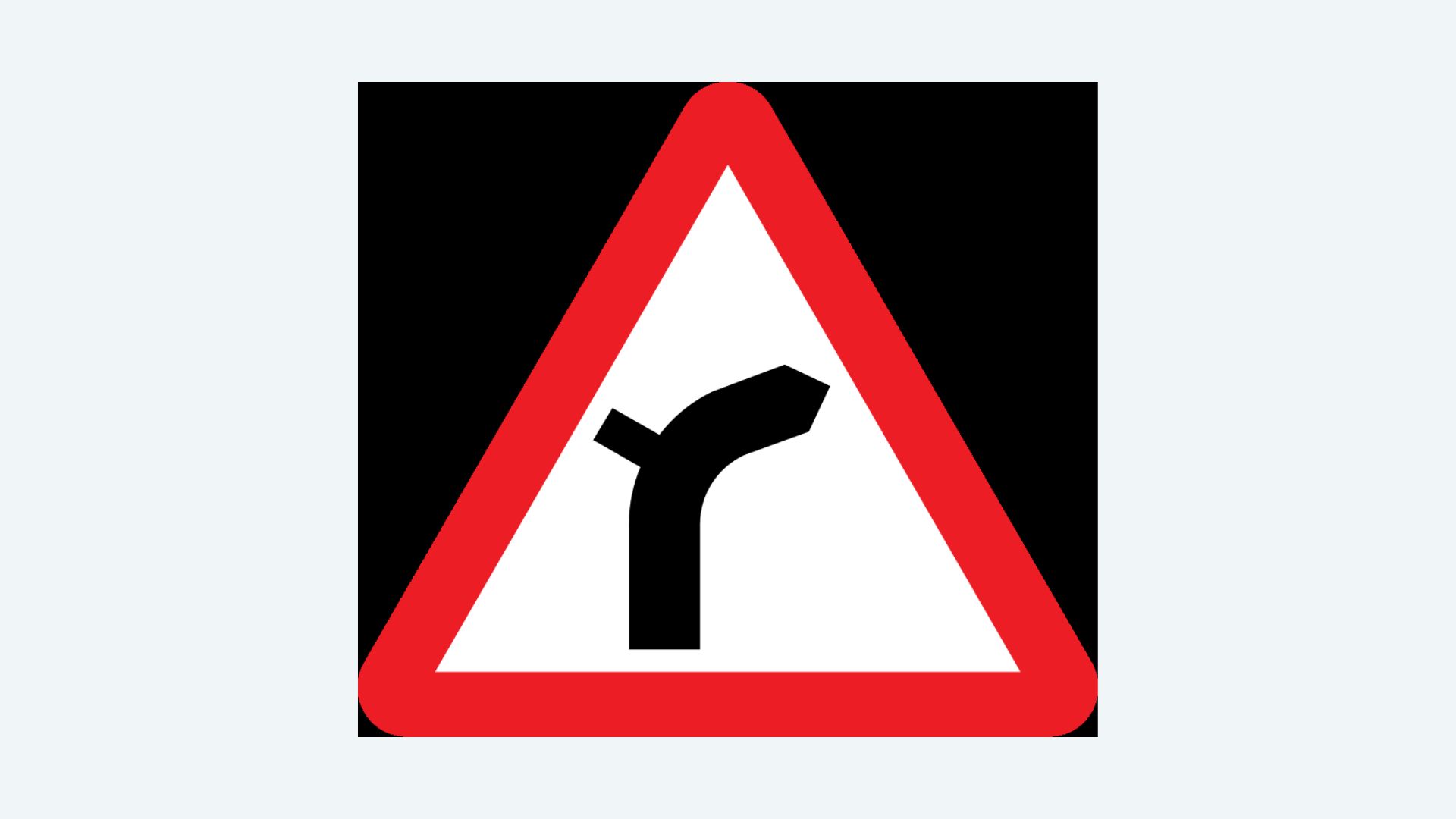
This sign is commonly found in rural areas or on winding country roads, particularly in locations where limited visibility increases the risk of collisions. It helps drivers anticipate that the upcoming bend is not just a simple curve, but that a side road joins the main road while navigating the bend. This is a combined warning sign, showing both a curve and a side road symbol. Depending on the direction of the bend, the curve may point to the left or right, and the side road may join the main road from the inside or outside of the bend. On these signs, the main road is often shown with a thicker line to indicate priority of movement.
6. Traffic Merging Ahead:
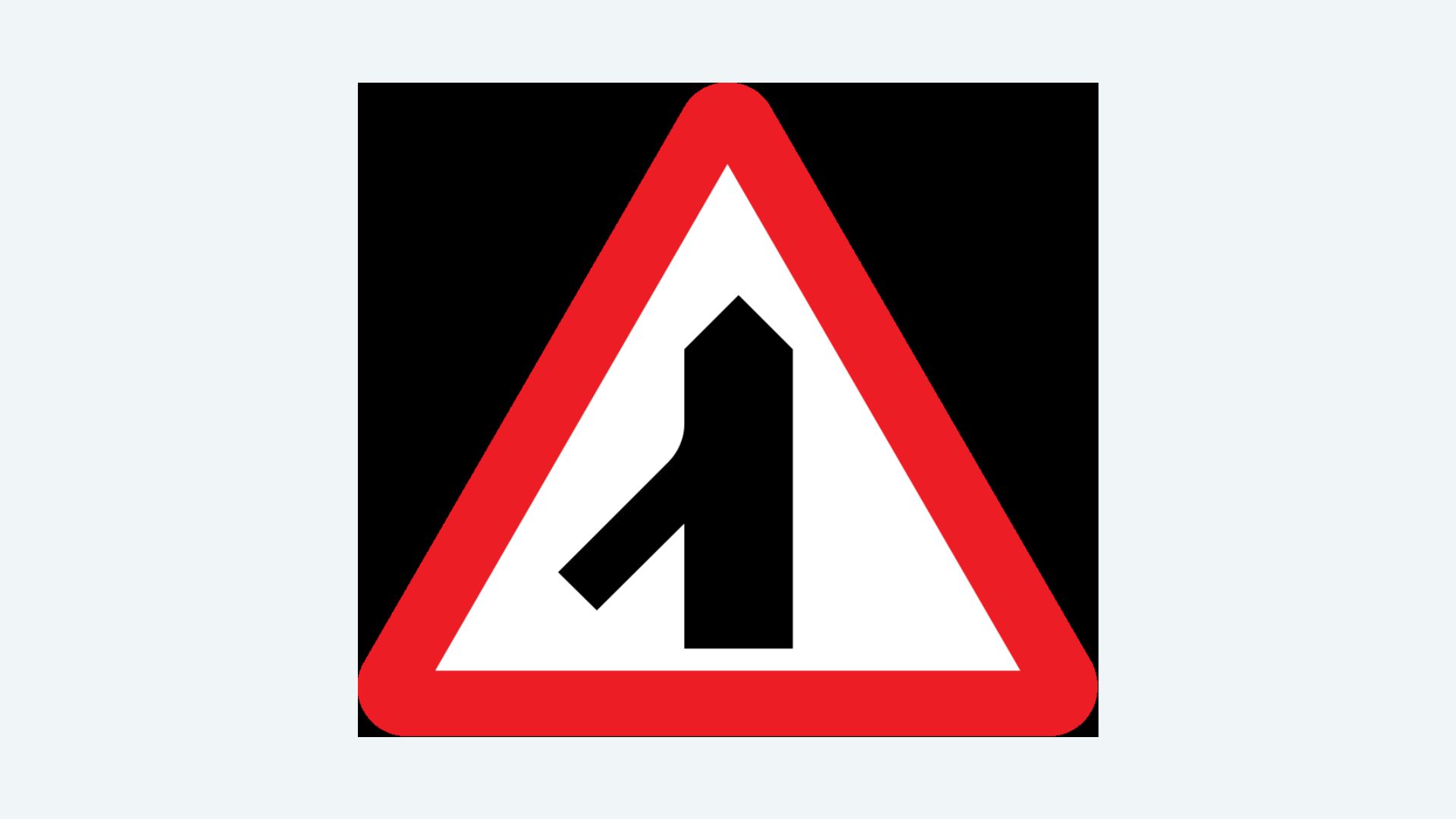
This sign is another type of warning sign, alerting drivers on the main road that a side road is about to merge ahead. Unlike previous junction signs, this one indicates that the side road joins the main road gradually, and does not cut across the flow of traffic like at a crossroads. It is commonly seen on dual carriageways and motorways at slip roads or where two lanes merge further ahead. It is also used on primary roads where a climbing lane ends, or where a side road has a short acceleration lane to merge onto a main road. On this sign, the thicker line represents the higher-priority route, indicating that traffic on the main road generally has priority. However, all drivers should pay close attention to road safety when merging.
7. Roundabout Ahead
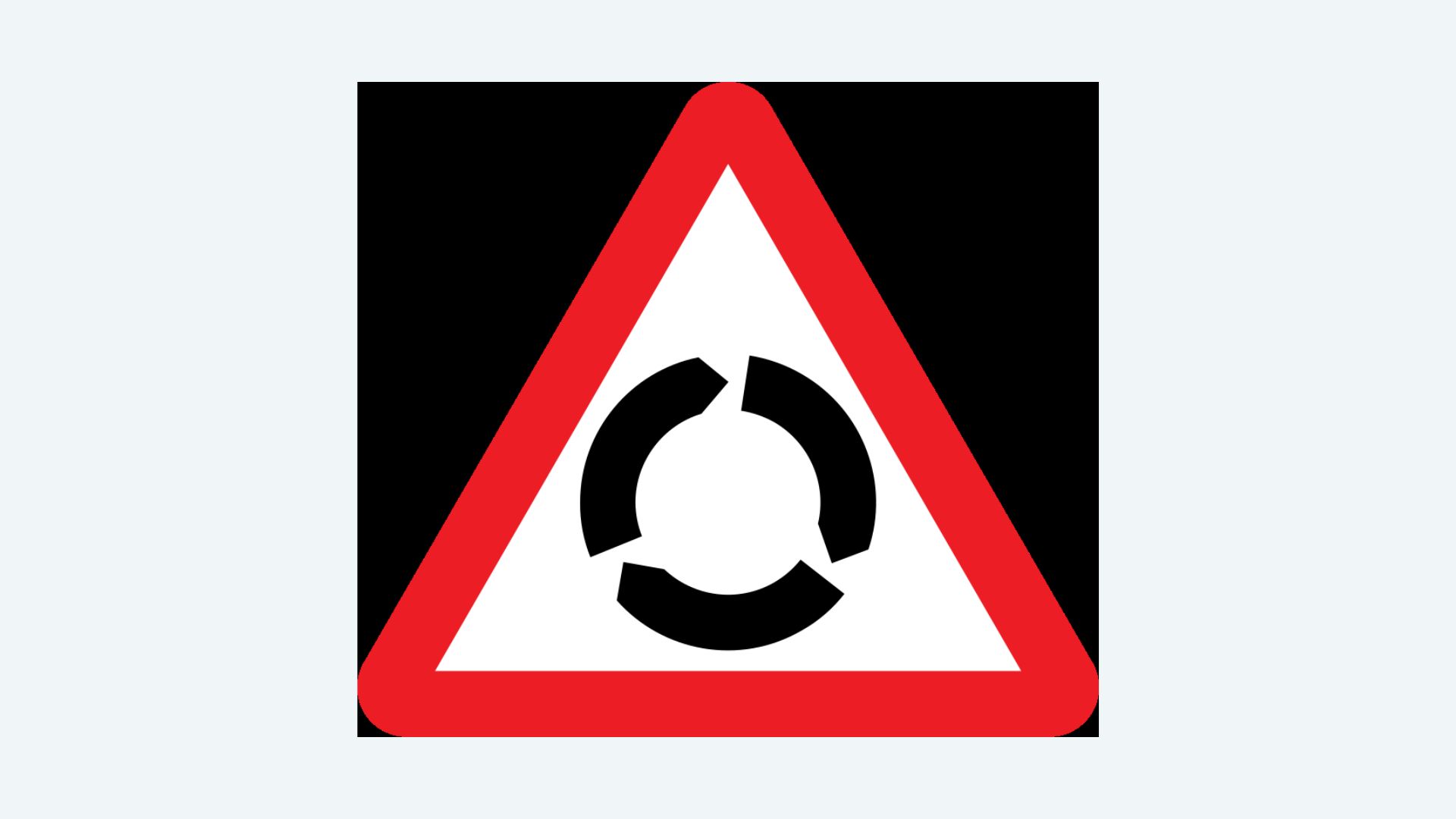
A triangular warning sign with a white background and red border, featuring three black arrows chasing each other in a circular formation, indicates a roundabout ahead, where traffic flows around a central island. Unlike a crossroads, a roundabout in the UK requires vehicles to turn to the right and give way to traffic already on the roundabout (approaching from the right). This sign does not depict the precise layout of the roundabout, but it warns drivers to prepare for a roundabout junction ahead.
This sign is placed in advance of both small and large roundabouts. If the roundabout is not immediately after the sign, it is usually accompanied by an additional sign indicating the distance to the roundabout. It is commonly seen before virtually all roundabouts across the UK, and it is especially important on high-speed roads where slowing down significantly is necessary to negotiate the roundabout safely.
A roundabout is a type of junction control, and while it may not resemble a conventional “crossroads”, this sign plays a vital role in navigating junctions throughout the UK.
How to Interpret Crossroad Signs
Signs Indicating Priority at Crossroads
What sets the Crossroad Sign apart from other warning signs is its illustration. On the sign you’ll see a picture of two roads crossing each other. In truth, it looks somewhat like a “t”. The photo is a black illustration which is clear to see against its white background. The illustration in the center will vary based upon the layout of the crossroad such as what side of the road has priority.
Interpreting Signals and Signs at Busy Intersections
Road markings and lights help safely control traffic at intersections. Some common markings you might see at a crossroad or intersection include a white line that tells the car to wait behind the line until it is clear for them to go. Priority road markings such as a double broken white line that alerts the driver that they are going from a minor road to a major road are also common at crossroads. There could also be Stop signs or traffic lights if it is a busy intersection. Did you know that there could be a penalty if you don’t obey the road markings or ignore the traffic signs at crossroads? Disobeying traffic rules is considered a traffic offense which, if found guilty, could cost you in fines and potentially other problems like points against your driving record. In the following text we will talk about some road signs which you may see before crossroads and what you should do when you see them, follow us to the end:
What Should You Do When You See This Sign at a Crossroads?
Whether you’re driving on rural roads (where, due to limited visibility, you may not be able to spot roads joining the main road until you’re very close — and unmarked junctions are also more common in these areas) or in urban areas (where driving speeds are lower than in the countryside, but there are more potential hazards such as pedestrians, cyclists, parked cars which may restricted your visibility), it’s important to bear the following points in mind when observing road signs:
1 – The first step when approaching any junction is to reduce your speed and proceed with caution:
When you see warning signs such as:
Crossroads Ahead, T-Junction Ahead, Side Road Ahead, Staggered Junction Ahead, Junction on Bend Ahead you should:
Begin to slow down. However, it is not enough to simply reduce your speed to the legal limit; you must slow down enough so that you can stop safely if necessary.
For example, the Highway Code advises drivers to reduce your speed at approaches to bends, junctions, and turnings” when driving on rural roads, because these junctions may be partially hidden. Even when the national speed limit is in place, it might not be safe to continue at that speed if you’re approaching a crossroads and you should be able to stop your vehicle immediately if its necessary.
Here I will explain briefly necessary steps that you must do when see some common crossroad signs in the UK roads:
1. Crossroads Ahead Sign:

When you are driving in UK roads and face with this road sign you should:
-
Slow down and be ready to stop if necessary.
-
Look out for traffic coming from both the left and right because it said you will be arrive to crossroad.
-
Check who has priority — because in some roads you may not have clear markings like give way or stop signs.
-
Approach with caution, especially if visibility is limited or it’s a busy junction.
-
Remember this sign doesn’t show priority, so don’t assume you have the right of way — always be alert and assess the situation at the junction.
2. T-Junction Ahead:

When you are approaching to T-Junction crossroads you should: 1- Reduce your speed. Its important because T-junctions can present unexpected hazards, such as vehicles pulling out or pedestrians crossing.
2- Be ready to stop or yield the right of way depending on the road markings and traffic signs, you might need to give way to traffic coming from the right or left.
3- Always check both directions of traffic before turning especially at the top of the “T” where other vehicles might be coming from a side road.
4- Stay in the appropriate lane for your intended turn: its imortant to position your vehicle closer to the edge of the road for a smoother turn.
5- Be aware of visibility: Sometimes, T-junctions are located in areas with limited visibility. Make sure to look well ahead for any hazards and adjust your speed accordingly.
6- Stay alert for pedestrians and cyclists: Always be carefule about pedestrians or cyclists who may be crossing or approaching of the junction.
3. Side Road Ahead:

Side Road Ahead sign indicates that a smaller road joining the main road from the left or right. When you see this sign you should:
1- Be prepared for vehicles emerging from the side road. Although you have priority, you must be ready to react quickly if you face with careless drivers who emerges from the side road unexpectedly.
2- By reducing your speed you can react better if you face with unexpeected situation.
3- Check your mirrors and be aware of vehicles behind you that might be tailgating.
4- Be careful about pedestrians and cyclists: In addition to vehicles, pedestrians and cyclists may be using or crossing the side road. Ensure you are ready to stop if needed.
5- Look both ways: If you need to give way to any traffic entering the main road from the side road, always check in both directions for vehicles coming from that side road.
6- Keep a safe distance from vehicles ahead of you.
4. Staggered Junction Ahead:

Like other crossroads in this kind of junction its better to consider these points:
-
Slow down: Approach the staggered junction with reduced speed, as it may require more careful maneuvering and awareness of other road users.
-
Be prepared to stop: Since staggered junctions can be confusing, especially with turning vehicles, be prepared to stop if necessary, or yield the right of way to other vehicles or pedestrians.
-
Look out for road signs or markings that indicate which road has priority and whether you need to give way to traffic from the side roads. This can vary depending on the exact location of the junction.
-
Be extra cautious and check for vehicles from both directions, as cars may be turning from both staggered roads, and visibility could be limited.
-
Position your vehicle properly: Stay in the correct lane for your intended direction, especially if you need to turn left or right at the staggered junction.
-
Look for cyclists and pedestrians:
5. Junction on Bend Ahead:

As same as other junctions you should consider the points which I mentioned before but for this kind of junctions you should remember these points too:
-
Be extra cautious and avoid speeding into the bend In this kind of junction you have limited visibility: Because the junction is located on a bend, your view may be obstructed, especially if the bend is sharp. This kind of junctions can make it difficult to see vehicles or pedestrians approaching it. Be extra cautious and avoid speeding into the bend, as you may not have enough time to react to anything coming out of the junction.
-
Increased Stopping Distance: Due to the curve in the road, you may not have a clear line of sight ahead. This means you need to increase your following distance from the vehicle in front to allow for more time to react in case the car in front of you stops suddenly or there is an obstruction ahead.
-
Becarful more in rainy or icy conditions: Bends become even more hazardous, and the junction may be more slippery. Always reduce your speed and be prepared for potential loss of traction, especially when turning into or out of the junction.
-
Turning into the Junction: If you’re turning into a junction on a bend, you may need to adjust your steering and position more than usual. It’s often safer to slow down even further before making the turn, as the bend can affect your ability to judge distances accurately.


